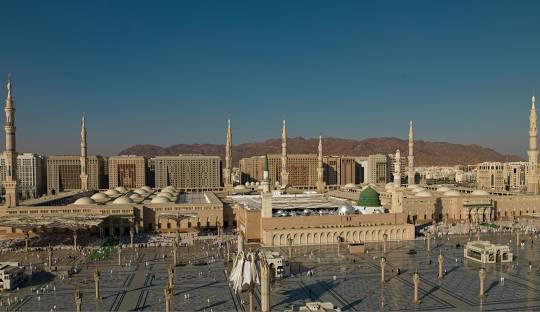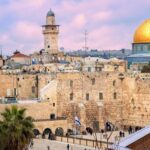Medina.. the home of the Prophet’s migration and the first Islamic capital
The first capital in the history of Islam, and the second holiest place for Muslims after Mecca. The Messenger Muhammad, may God bless him and grant him peace, migrated to it, coming from Mecca after the harm he faced with the Muslims from the leaders of the Quraish. It is there that the first mosque was built and contains his honorable grave. It is the capital of the Medina region, located on the historical land of Hijaz, west of the Kingdom of Saudi Arabia.
Location:
Medina is located in western Saudi Arabia, about 400 km northeast of Mecca , and 150 km east of the Red Sea. The closest port to it is Yanbu Port, which is located on the western-southern side of it, and is 220 km away.
Its area is about 589 km², of which 99 km² is occupied by the urban area, while the rest of the area is outside the urban area, and consists of mountains, valleys, flood slopes, desert lands, and agricultural lands.
It is characterized by a desert climate characterized by drought, low rainfall, and high temperatures ranging between 30 and 45 degrees Celsius in the summer, while in the winter the weather is rainy, and rainfall is frequent in April, with the possibility of it falling in the winter months.
Population:
The city’s population reached about two million people in 2022, according to the General Authority for Statistics in the Kingdom of Saudi Arabia, and they belong to different tribes and ethnicities, some of whom are people of the city who have lived there for centuries, some of whom are immigrants from all over the Kingdom of Saudi Arabia and various countries of the world to settle in it, and some of whom are newcomers. From Arab and Islamic countries to work in.
In addition to the permanent residents of the city, large numbers of visitors arrive there during the Hajj and Umrah seasons, especially in the month of Ramadan and the Hajj season. Their average number is approximately one million, and they stay there in successive batches for a few days and weeks, then return to their countries.
History
The founding of Medina – which was known in the past as “Yathrib” – goes back to about 1600 years before the Prophet’s migration , and its inhabitants have successively changed since its establishment. The Amalekites inhabited it, and after them the Ma’inite tribes from Yemen, and then the Jews who arrived there for the first time during the century. 2nd AD.
Among the most prominent Jewish tribes that inhabited the city were the Banu Qaynuqa, Banu Qurayza, and Banu al-Nadir. Later, following the collapse of the Ma’rib Dam in Yemen, several Arab tribes arrived, including the Aws and Khazraj tribes, which settled there with the presence of the Jews. The two parties allied themselves and agreed to cooperate to protect the city. They protected the city from foreign invasion, and they committed to doing so for a period of time during which the number of Aws and Khazraj increased and their wealth grew.
The Aws and Khazraj turned into bitter enemies years after their arrival in Yathrib, and sources state that the Jews feared the expansion of the power and influence of the two tribes, so they separated and ensnared them.
In the seventh century AD, Islam appeared in Mecca at the hands of the Messenger of God, Muhammad, may God bless him and grant him peace, and his call for the new religion caused the anger of the Quraysh masters who lived in Mecca, so they prepared all methods for him to thwart his call, so he migrated to Yathrib after he agreed with a delegation from the Aws and Khazraj who were He met him during the Hajj season, and he believed in the Prophet and believed in Islam.
All of the Prophet’s conquests, may God bless him and grant him peace, launched from Medina. It was subjected to siege in the Battle of the Trench , and from there the Messenger would send his messengers and books to kingdoms and regions and receive delegations there. It had the same role during the reign of Abu Bakr and after him, so Medina was considered the capital of the Rightly Guided Caliphate, until Muawiyah bin Abi Sufyan founded the Umayyad state and made Damascus its capital.
Landmarks:
Medina includes the Prophet’s Mosque, which is the second holiest place of worship for Muslims after the Grand Mosque in Mecca, and it is one of the three most visited mosques in Islam: the Grand Mosque in Mecca, the Al-Aqsa Mosque in Jerusalem, and the Prophet’s Mosque in Medina.
The Prophet’s Mosque is located in the heart of the city, and was built in the place where the Prophet’s she-camel blessed when he came to the city as an immigrant. The Prophet’s Mosque includes many landmarks, the most prominent of which are his grave, may God bless him and grant him peace, which is located under the green dome, and his pulpit, about which he said that what is between him and his grave is a garden of Paradise.
There is also the Quba Mosque in the city, which is the first mosque built in Islam. It is located in the south of the city and is about five kilometers away from the Prophet’s Mosque. There is also the Mosque of the Two Qiblas, and the reason for its name is that the Companions prayed one prayer in it, facing two qiblahs, because the qiblah was at that time towards Jerusalem, and when the verse about changing the qibla to the Sacred Mosque was revealed, the Prophet sent someone to inform the Muslims on the outskirts of the city, and the news came to the people praying in this mosque and they were They arrive in Jerusalem, and while praying, they turn to the new qibla.
Also among the landmarks of Medina is Al-Baqi Cemetery, which is the main cemetery since the era of the Prophet , and one of the closest historical places to the Prophet’s Mosque, as it is located facing the southeastern part of the mosque’s wall. Its current area is about 180 thousand square meters, and it contains the remains of thousands of the people of Medina. Neighbors and visitors died there, led by the Companions, as it includes approximately ten thousand companions who were buried there.
The city also has the Uhud Martyrs Cemetery. It is located north of the Prophet’s Mosque, five kilometers away, at the foot of Mount Uhud (which is considered one of the most important natural and religious landmarks in the city) and next to Mount Archers. It was given this name because it contains the remains of seventy companions who were martyred in the Battle of Uhud, including Hamza bin Abdul Muttalib, uncle of the Prophet, may God bless him and grant him peace.


